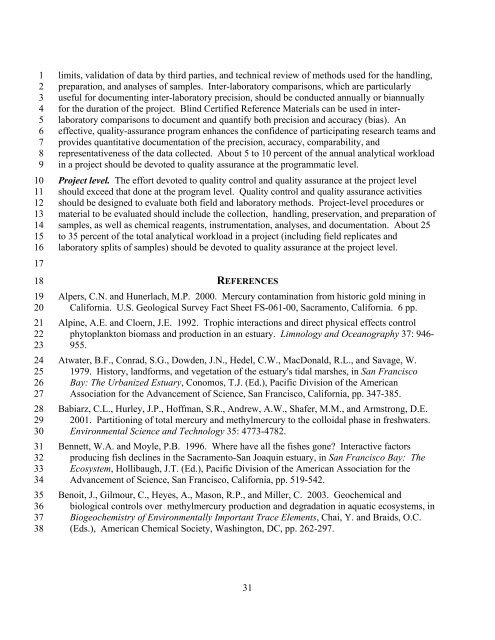Mercury Strategy for the Bay-Delta Ecosystem - CALFED Bay-Delta ...
Mercury Strategy for the Bay-Delta Ecosystem - CALFED Bay-Delta ...
Mercury Strategy for the Bay-Delta Ecosystem - CALFED Bay-Delta ...
Create successful ePaper yourself
Turn your PDF publications into a flip-book with our unique Google optimized e-Paper software.
1<br />
2<br />
3<br />
4<br />
5<br />
6<br />
7<br />
8<br />
9<br />
10<br />
11<br />
12<br />
13<br />
14<br />
15<br />
16<br />
17<br />
18<br />
19<br />
20<br />
21<br />
22<br />
23<br />
24<br />
25<br />
26<br />
27<br />
28<br />
29<br />
30<br />
31<br />
32<br />
33<br />
34<br />
35<br />
36<br />
37<br />
38<br />
limits, validation of data by third parties, and technical review of methods used <strong>for</strong> <strong>the</strong> handling,<br />
preparation, and analyses of samples. Inter-laboratory comparisons, which are particularly<br />
useful <strong>for</strong> documenting inter-laboratory precision, should be conducted annually or biannually<br />
<strong>for</strong> <strong>the</strong> duration of <strong>the</strong> project. Blind Certified Reference Materials can be used in interlaboratory<br />
comparisons to document and quantify both precision and accuracy (bias). An<br />
effective, quality-assurance program enhances <strong>the</strong> confidence of participating research teams and<br />
provides quantitative documentation of <strong>the</strong> precision, accuracy, comparability, and<br />
representativeness of <strong>the</strong> data collected. About 5 to 10 percent of <strong>the</strong> annual analytical workload<br />
in a project should be devoted to quality assurance at <strong>the</strong> programmatic level.<br />
Project level. The ef<strong>for</strong>t devoted to quality control and quality assurance at <strong>the</strong> project level<br />
should exceed that done at <strong>the</strong> program level. Quality control and quality assurance activities<br />
should be designed to evaluate both field and laboratory methods. Project-level procedures or<br />
material to be evaluated should include <strong>the</strong> collection, handling, preservation, and preparation of<br />
samples, as well as chemical reagents, instrumentation, analyses, and documentation. About 25<br />
to 35 percent of <strong>the</strong> total analytical workload in a project (including field replicates and<br />
laboratory splits of samples) should be devoted to quality assurance at <strong>the</strong> project level.<br />
REFERENCES<br />
Alpers, C.N. and Hunerlach, M.P. 2000. <strong>Mercury</strong> contamination from historic gold mining in<br />
Cali<strong>for</strong>nia. U.S. Geological Survey Fact Sheet FS-061-00, Sacramento, Cali<strong>for</strong>nia. 6 pp.<br />
Alpine, A.E. and Cloern, J.E. 1992. Trophic interactions and direct physical effects control<br />
phytoplankton biomass and production in an estuary. Limnology and Oceanography 37: 946-<br />
955.<br />
Atwater, B.F., Conrad, S.G., Dowden, J.N., Hedel, C.W., MacDonald, R.L., and Savage, W.<br />
1979. History, land<strong>for</strong>ms, and vegetation of <strong>the</strong> estuary's tidal marshes, in San Francisco<br />
<strong>Bay</strong>: The Urbanized Estuary, Conomos, T.J. (Ed.), Pacific Division of <strong>the</strong> American<br />
Association <strong>for</strong> <strong>the</strong> Advancement of Science, San Francisco, Cali<strong>for</strong>nia, pp. 347-385.<br />
Babiarz, C.L., Hurley, J.P., Hoffman, S.R., Andrew, A.W., Shafer, M.M., and Armstrong, D.E.<br />
2001. Partitioning of total mercury and methylmercury to <strong>the</strong> colloidal phase in freshwaters.<br />
Environmental Science and Technology 35: 4773-4782.<br />
Bennett, W.A. and Moyle, P.B. 1996. Where have all <strong>the</strong> fishes gone? Interactive factors<br />
producing fish declines in <strong>the</strong> Sacramento-San Joaquin estuary, in San Francisco <strong>Bay</strong>: The<br />
<strong>Ecosystem</strong>, Hollibaugh, J.T. (Ed.), Pacific Division of <strong>the</strong> American Association <strong>for</strong> <strong>the</strong><br />
Advancement of Science, San Francisco, Cali<strong>for</strong>nia, pp. 519-542.<br />
Benoit, J., Gilmour, C., Heyes, A., Mason, R.P., and Miller, C. 2003. Geochemical and<br />
biological controls over methylmercury production and degradation in aquatic ecosystems, in<br />
Biogeochemistry of Environmentally Important Trace Elements, Chai, Y. and Braids, O.C.<br />
(Eds.), American Chemical Society, Washington, DC, pp. 262-297.<br />
31

















